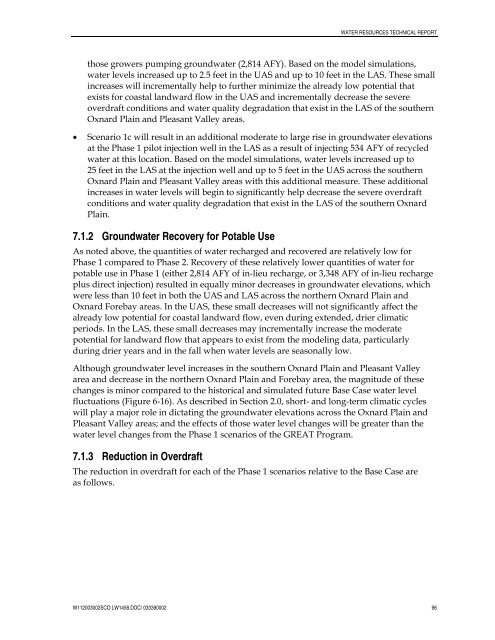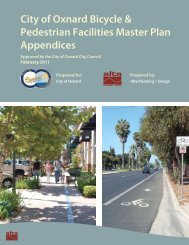View File - Development Services - City of Oxnard
View File - Development Services - City of Oxnard
View File - Development Services - City of Oxnard
Create successful ePaper yourself
Turn your PDF publications into a flip-book with our unique Google optimized e-Paper software.
WATER RESOURCES TECHNICAL REPORTthose growers pumping groundwater (2,814 AFY). Based on the model simulations,water levels increased up to 2.5 feet in the UAS and up to 10 feet in the LAS. These smallincreases will incrementally help to further minimize the already low potential thatexists for coastal landward flow in the UAS and incrementally decrease the severeoverdraft conditions and water quality degradation that exist in the LAS <strong>of</strong> the southern<strong>Oxnard</strong> Plain and Pleasant Valley areas.• Scenario 1c will result in an additional moderate to large rise in groundwater elevationsat the Phase 1 pilot injection well in the LAS as a result <strong>of</strong> injecting 534 AFY <strong>of</strong> recycledwater at this location. Based on the model simulations, water levels increased up to25 feet in the LAS at the injection well and up to 5 feet in the UAS across the southern<strong>Oxnard</strong> Plain and Pleasant Valley areas with this additional measure. These additionalincreases in water levels will begin to significantly help decrease the severe overdraftconditions and water quality degradation that exist in the LAS <strong>of</strong> the southern <strong>Oxnard</strong>Plain.7.1.2 Groundwater Recovery for Potable UseAs noted above, the quantities <strong>of</strong> water recharged and recovered are relatively low forPhase 1 compared to Phase 2. Recovery <strong>of</strong> these relatively lower quantities <strong>of</strong> water forpotable use in Phase 1 (either 2,814 AFY <strong>of</strong> in-lieu recharge, or 3,348 AFY <strong>of</strong> in-lieu rechargeplus direct injection) resulted in equally minor decreases in groundwater elevations, whichwere less than 10 feet in both the UAS and LAS across the northern <strong>Oxnard</strong> Plain and<strong>Oxnard</strong> Forebay areas. In the UAS, these small decreases will not significantly affect thealready low potential for coastal landward flow, even during extended, drier climaticperiods. In the LAS, these small decreases may incrementally increase the moderatepotential for landward flow that appears to exist from the modeling data, particularlyduring drier years and in the fall when water levels are seasonally low.Although groundwater level increases in the southern <strong>Oxnard</strong> Plain and Pleasant Valleyarea and decrease in the northern <strong>Oxnard</strong> Plain and Forebay area, the magnitude <strong>of</strong> thesechanges is minor compared to the historical and simulated future Base Case water levelfluctuations (Figure 6-16). As described in Section 2.0, short- and long-term climatic cycleswill play a major role in dictating the groundwater elevations across the <strong>Oxnard</strong> Plain andPleasant Valley areas; and the effects <strong>of</strong> those water level changes will be greater than thewater level changes from the Phase 1 scenarios <strong>of</strong> the GREAT Program.7.1.3 Reduction in OverdraftThe reduction in overdraft for each <strong>of</strong> the Phase 1 scenarios relative to the Base Case areas follows.W112003002SCO LW1458.DOC/ 033390002 96
















